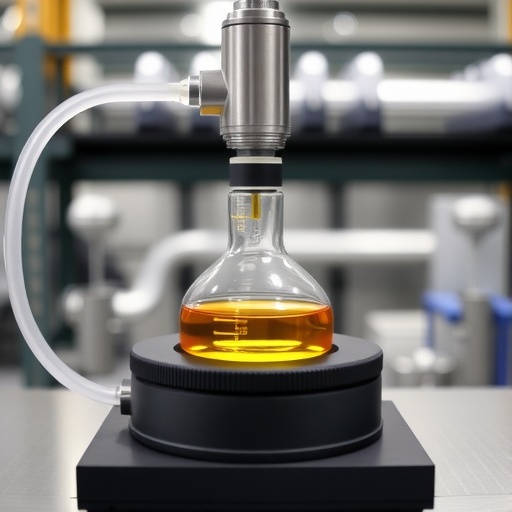Pressure Makes Perfect: ECU Innovator Revolutionizes Essential Oil Production with Instantaneous Controlled Pressure Drop Technology
In the realm of natural product extraction, essential oils hold a unique place, serving various industries ranging from food and fragrance to cosmetics and pharmaceuticals. However, traditional methods of extracting these volatile compounds often grapple with inefficiencies such as low yields, long processing times, and thermal degradation of heat-sensitive bioactives. A breakthrough approach developed by a researcher at Edith Cowan University (ECU) promises to upend this status quo by introducing a cutting-edge extraction technique that leverages pressure dynamics, known as Instantaneous Controlled Pressure Drop (CID) technology.
Muhammad Hassnain, a PhD candidate at ECU, has been pioneering the refinement of CID technology as a transformative solution for essential oil extraction. This methodology operates fundamentally differently from conventional approaches by employing cycles of abrupt compression and decompression, altering the microstructure of plant materials to facilitate enhanced heat and mass transfer. As a result, the technique not only expedites the extraction process but also significantly boosts essential oil yield while reducing energy consumption.
Traditional extraction methods often rely on prolonged heat application or the use of large quantities of solvents, factors that inherently limit efficiency and can lead to the degradation of delicate oil components. In contrast, CID technology capitalizes on the physical effects of sudden pressure drops to induce rapid vaporization of volatile compounds. The process starts by subjecting plant material to brief exposure to highly saturated steam, followed by a precipitous pressure descent that creates a vacuum, thereby triggering instantaneous evaporation of essential oils.
This rapid vaporization is crucial, as it generates cycles in which a condensed emulsion composed of water and volatile oil compounds forms within a vacuum tank. The abrupt volumetric expansion associated with pressure drops ensures rapid cooling of the extracted emulsions, effectively preventing thermal degradation. As such, CID technology harmonizes the kinetics of thermal and mechanical forces to maintain oil integrity while optimizing output.
One of the most compelling advantages of this approach lies in its sustainability credentials. By drastically reducing the energy input needed to sustain prolonged heating and solvent use, CID presents a low-impact alternative that curtails environmental footprint. Moreover, the solvent-free nature of the extraction process aligns with growing consumer demand for cleaner, eco-friendly, and residue-free essential oils.
Hassnain’s work, conducted under the guidance of Dr. Muhammad Rizwan Azhar and in partnership with industry collaborators, showcases the scalability potential of CID technology through its application in the extraction of sandalwood oils indigenous to both India and Australia. Sandalwood oils are prized in perfumery and therapeutics, and enhancements in their extraction efficiency could resonate across global markets.
A comprehensive review co-authored by Hassnain elucidates three commercial CID variants currently in use, each characterized by cycles of steaming and sudden pressure declines. These variants illustrate the industrial readiness of CID technology, transitioning it from laboratory novelty toward mainstream adoption. The cyclic nature of CID lends itself to continuous processing frameworks, thereby aligning with modern manufacturing imperatives for throughput and consistency.
From a thermodynamic perspective, CID technology capitalizes on the sudden pressure drop to induce flash evaporation, a process that fundamentally differs from slow distillation or solvent extraction methods. By manipulating vapor-liquid equilibria swiftly, essential oils are liberated before their chemical structure can degrade, safeguarding both fragrance profiles and therapeutic properties.
The technology’s integrative application of thermo-mechanical phenomena not only speeds mass transfer rates within plant matrices but also promotes fracture and porosity enhancements at the microstructural level. This dynamic restructuring facilitates deeper penetration of heat and facilitates easier vapor diffusion, culminating in more robust extraction efficiency.
Industry observers take note of the potential implications: shorter extraction times can translate to faster production cycles and reduced bottlenecks in supply chains. Additionally, improved yields could lower raw material demands, enhancing the sustainability and economics of essential oil production industries worldwide.
Despite being a relatively novel process, CID stands poised for significant impact due to its multifaceted advantages, including energy savings, higher output, and preservation of essential oil quality. As global demand for natural, high-purity essential oils continues to surge, innovations like CID technology could redefine extraction standards.
Looking ahead, ECU’s ongoing research collaborations aim to refine process parameters further, optimizing for different plant species and essential oil types. The potential for customizing pressure-drop schedules, temperature profiles, and cycle durations opens avenues for tailoring extraction protocols to maximize efficiency and product purity across diverse botanical sources.
Ultimately, the instantaneous controlled pressure drop method exemplifies how advanced engineering principles can harmonize with natural product industries to drive sustainable, high-quality production. This breakthrough may well establish a new benchmark for essential oil extraction, combining scientific ingenuity with commercial viability.
Subject of Research:
Essential oil extraction process intensification using Instantaneous Controlled Pressure Drop (CID) technology.
Article Title:
Process intensification of essential oils extraction using instantaneous controlled pressure drop technology
News Publication Date:
[Not explicitly stated in original content; publication date of article is 1-Dec-2025]
Web References:
https://www.sciencedirect.com/science/article/pii/S0255270125003794?via%3Dihub
http://dx.doi.org/10.1016/j.cep.2025.110533
Keywords:
Agricultural intensification, Agricultural engineering, Systems engineering
Tags: advancements in natural product extractionbenefits of CID technology for essential oilsECU innovations in essential oilsefficient extraction processes for natural productsenhancing yield in essential oil productionessential oil extraction techniquesheat-sensitive bioactives preservationInstantaneous Controlled Pressure Drop technologypressure dynamics in extractionreducing energy consumption in extractionrevolutionary techniques in essential oil productionsustainable methods for extracting essential oils





